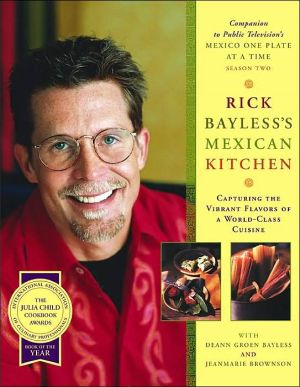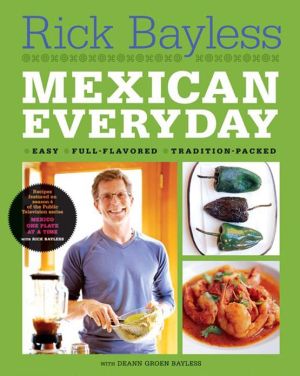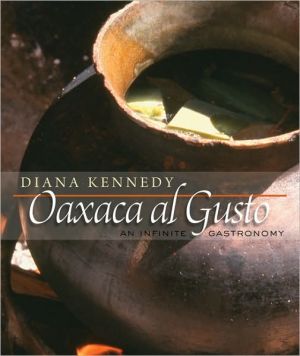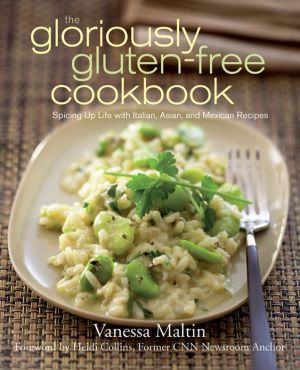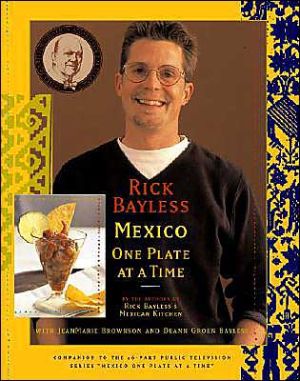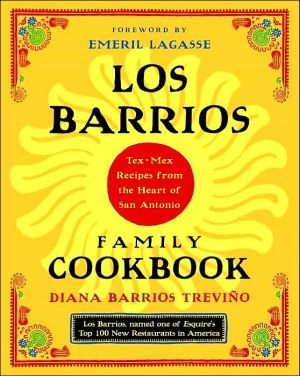Rick Bayless's Mexican Kitchen: Recipes and Techiniques of a World-Class Cuisine
BURSTING WITH BOLD, COMPLEX FLAVORS, Mexican cooking has the kind of gusto we want in food today. Until now, American home cooks have had few authorities to translate the heart of this world-class cuisine to everyday cooking.\ In this book of more than 150 recipes, award-winning chef, author and teacher Rick bayless provides the inspiration and guidance that home cooks have needed. With a blend of passion, patience, clarity and humor, he unerringly finds his way into the very soul of Mexican...
Search in google:
BURSTING WITH BOLD, COMPLEX FLAVORS, Mexican cooking has the kind of gusto we want in food today. Until now, American home cooks have had few authorities to translate the heart of this world-class cuisine to everyday cooking.In this book of more than 150 recipes, award-winning chef, author and teacher Rick bayless provides the inspiration and guidance that home cooks have needed. With a blend of passion, patience, clarity and humor, he unerringly finds his way into the very soul of Mexican cuisine, from essential recipes and explorations of Mexico's many chiles to quick-to-prepare everyday dishes and pull-out-the-stops celebration fare.Bayless begins the journey by introducing us to the building blocks of Mexican cooking. With infectious enthusiasm and an entertaining voice, he outlines 16 essential preparations-deeply flavored tomato sauces and tangy tomatillo salsas, rich chile pastes and indispensable handmade tortillas.Fascinating cultural background and practical cooking tips help readers to understand these preparations and make them their own. Each recipe explains which steps can be completed in advance to make final preparation easier, and each provides a list of the dishes in later chapters that are built around these basics. And with each essential recipe, Bayless includes several "Simple Ideas from My American Home"-quick, familiar recipes with innovative Mexican accents, such as Baked Ham with Yucatecan Flavors, Spicy Chicken Salad, Ancho-Broiled Salmon and Very, Very Good Chili. Throughout, the intrepid Bayless brings chiles into focus, revealing that Mexican cooks use these pods for flavor, richness, color and, yes, sometimes for heat. He details the simpletechniques for getting the best out of every chile-from the rich, smoky chipotle to the incendiary but fruity habanero.Then, in more than 135 recipes that follow, Bayless guides us through a wide range of richly flavored regional Mexican dishes, combining down-home appeal and convivial informality with simple culinary elegance. It's all here: starters like Classic Seviche Tostadas or Chorizo-Stuffed Ancho Chiles; soups like Slow-Simmered Fava Bean Soup or Rustic Ranch-Style Soup; casual tortilla-based preparations like Achiote-Roasted Pork Tacos or Street-Style Red Chile Enchiladas; vegetable delights like Smoky Braised Mexican Pumpkin, or Green Poblano Rice; even a whole chapter on classic fiesta food (from Oaxacan Black Mole with Braised Chicken, Smoky Peanut Mole with Grilled Quail and Great Big Tamal Roll with Chard with the incomparable Juchitan-Style Black Bean Tamales); and ending with a selection of luscious desserts like Modern Mexican Chocolate Flan with KahIua and Yucatecan-Style Fresh Coconut Pie. To quickly expand your Mexican repertoire even further, each of these recipes is accompanied by suggestions for variations and improvisations.There is no greater authority on Mexican cooking than Rick Bayless, and no one can teach it better. In his skillful hands, the wonderful flavors of Mexico will enter your kitchen and your daily cooking routine without losing any of their depth or timeless appeal. Publishers Weekly This definitive collection from Chicago chef and James Beard Award winner Bayless, in collaboration with his wife (and fellow restaurateur) and food journalist Brownson, proves comprehensively that the best Mexican food requiresand amply rewardsdedication and, often, time. Bayless begins with 15 Essential Recipes for salsas and sauces that work as "building blocks." Substitutions are suggested for uncommon ingredients, and excellent descriptions identify fresh and dried peppers. Throughout the text, sidebars inform about such items as tortilla presses, cactus paddles, pumpkin seeds and the delicacy huitlacoche (black corn fungus). Bayless explains fat's importance in the Mexican diet and tells how to make good lard at home. The chapter on salads includes two versions of guacamole, one given a fresh twist with roasted tomatillos; the chapter on soups offers Chilied Tortilla Soup with Shredded Chard and Oaxacan Black Bean Soup. An array of authentic Mexican fare is explored in "Tacos, Enchiladas and Other Casual Fare" (Simple Red Mole Enchiladas with Shredded Chicken) and "Vegetable, Bean, Rice and Egg Dishes" (e.g, Green Poblano Rice). "Fiesta Food" includes recipes for moles and tamales. Gringo cooks can relax with simpler main dishesRed Chile-Braised Chicken wreathed in ancho and garlic sauce, smoky Chipotle Shrimp or zesty Chile-Glazed Country Ribs. Desserts are as delectable as Modern Mexican Chocolate Flan and as unusual as Crunchy Amaranth Tart and Creamy Lime Pie. Mail-order sources and a bibliography are included. Photos not seen by PW. (Oct.)
Chapter One\ Essential Flavors of the Mexican Kithcen\ Every cuisine has classic combinations of flavor that emanate from its platters and plates. As distinctly recognizable as these combinations are (everyone knows when a dish tastes Italian or Moroccan or Thai), rarely are they as easy to isolate into building-block recipes as they are in Mexico. No one, though, has attempted this project — the dislodging of these cornerstones from full-built Mexican dishes — yet it's an exercise I think can be very useful when getting to know the Mexican kitchen. So I'm formalizing a first pass at it here, and what follows is the way my 15 Essential Recipes naturally group.\ All recipes, except the one for tortillas, make a salsa, sauce or seasoning. One group focuses on tomatoes (with fresh or dried chiles as flavorings), another on tomatillos (again with fresh or dried chiles), and a third on purees of rehydrated dried chiles. In addition, there's an essential recipe that focuses on fresh poblano chiles and one on the classic Yucatecan spice, achiote. These recipes together illustrate the principal flavor choruses that sing their way through dishes in Mexico. Some are utilized more than others, though I think most Mexican cooks would agree that each plays an essential role in the cuisine.\ Within the recipes that feature tomatoes, one (the Essential Simmered Tomato-Jalapeño Sauce) slowly simmers them into a sauce spiked with jalapeños and seared white onion, a second (Essential Simmered Tomato-Habanero Sauce) sizzles them in a pan with fruity, renegade habaneros, and a third (Essential Quick-Cooked Tomato-Chipotle Sauce) does the same with smoky chipotles and sweet garlic. Each has a different tomato texture, each a distinct profile resulting from its featured chile.\ Roasted tomatoes that don't receive any additional cooking (no further sizzling or simmering) get worked together with jalapeños, garlic and cilantro into a salsa (Essential Roasted Tomato-Jalapeño Salsa) that has both richness and robust freshness — a combination of characteristics you don't find in any of the cooked sauces. And if freshness is your passion, then one of the two chopped salsas will satisfy — either the classic mix of raw tomato, white onion, serrano and cilantro (Essential Chopped Tomato-Serrano Salsa) or the fiery, close cousin (Essential Chopped Tomato-Habanero Salsa) made with habaneros, plus radishes for crunch.\ Tomatillos offer a tangier backdrop than tomatoes. When they're simmered with serranos, onions and garlic in the Essential Simmered Tomatillo-Serrano Sauce, there is a mellow transformation in flavor and texture. Simply working together the same basic ingredients-no further cooking — creates a salsa (Essential Roasted Tomatillo-Serrano Salsa) with a rough texture that springs into a very zesty mouthful. Simply blend together roasted tomatillos with the smokiness of chipotles and the sweetness of roasted garlic, and you wind up with a salsa (Essential Roasted Tomatillo-Chipotle Salsa) that emphasizes tangy sweetness and fire.\ The seasonings and sauces made from purees of rehydrated dried chiles transform each chile's concentrated flavor into an even more concentrated (but less raucous) experience, filled in and balanced with herbs, spices and garlic. When you make the Essential Sweet-and-Spicy Ancho Seasoning Paste you'll notice that the rich, dried cherrylike ancho flavor comes to the fore, while natural bitterness fades. The near-molasses edge on the woodsy, dried-fruit punch of black pasillas is the focus of Essential Bold Pasilla Seasoning Paste; the tangy vegetal qualities of the chile are much less apparent.\ The Essential Simmered Guajillo Sauce pulls together the whirl of brilliant raw flavors into a well-proportioned sauce that casts sweetness against natural sharpness. And Essential Sweet-and-Smoky Chipotle Seasoning Salsa is an exercise in boldness: smokiness made even smokier by frying the dried chiles, roughness smoothed and piquancy concentrated by slowly cooking the puree, and everything balanced by plenty of sweetness from dark sugar and roasted garlic.\ We're a long way into these essential recipes to be just arriving at Essential Roasted Poblano Rajas. This simple mixture of rich-tasting roasted peppers, seared white onions, garlic and herbs, is without doubt quintessentially Mexican and thoroughly useful — it works with everything from condiments and salsas to salads, soups and casseroles.\ While you'll find several flavors of seasoning pastes in Yucatecan markets, the rusty-colored achiote one is known and used throughout Mexico. All the garlic, herbs and spices give it a baroque quality, though the earthy flavor of achiote is what this seasoning (Essential Garlicky Achiote Seasoning Paste) is all about.\ Corn tortillas are a backdrop to all Mexican flavor — more so than beans and rice, certainly more than flour tortillas. The Essential Corn Tortilla recipe gives detailed directions for how to make them. I include this recipe not because ready-made tortillas are difficult to find, but because I want to encourage you to (occasionally) make your own: The feel of the dough, the smell of a griddleful of golden rounds and the taste of a just-baked tortilla will teach you more about the Mexican table than anything else I can imagine.\ As you page through the rest of the book, you'll find that when one of these Essentials is the cornerstone of a recipe, we've highlighted it. I hope this will bring them to your attention, as well as bring to mind ways to utilize these basic flavors in dishes of your own creation. You may even find yourself making double or triple batches of your favorite Essentials to have on hand as a head start. In each dish that uses an Essential, I list the amount you'll need; if you already have the Essential made, simply measure out the appropriate quantity and move straight on to finishing the dish.\ ESSENTIAL SIMMERED TOAMTO-JALAPEÑO SAUCE\ Salsa de Fitomate Cocida\ You can taste the sear and sizzle in every spoonful of this well-known classic. Here the roasty sweetness of charred tomatoes and blistered chiles are all blended to a rough puree and seared in a hot pan. But why does tradition dictate that we go to the fuss of roasting and frying when a comforting sauce of canned tomatoes (perhaps with the familiar touch of tomato paste) could be slow-simmered with a little diced jalapeño? Because we want the earthy gustiness of Mexico here, not the slow-simmered sweetness of a typical pizza sauce. We're talking inimitable huevos rancheros of energetic tomato-doused sunnyside-up eggs on toasty corn tortillas.\ Choose plum tomatoes for a thicker texture, round tomatoes for a lighter, brothier consistency. This sauce is so versatile you can substitute it for any tomato sauce called for in this book.\ Makes 4 cups\ Generous 1 pound (about 2 large round, 8 to 10 plum) tomatoes\ 1 to 2 (about 3/4 ounce total) fresh jalapeño chiles, stemmed\ 1 tablespoon vegetable oil or rich-tasting lard\ 1/2 small (about 2 ounces) white onion, thinly sliced\ 1 1/2 cups chicken broth\ Salt, about 1 1/2 teaspoons, depending on the saltiness of the broth\ 1. Roasting the tomatoes and chiles. Roast the tomatoes and chiles on a baking sheet 4 inches below a very hot broiler until blistered and blackened on 1 side, about 6 minutes, then use tongs or a spoon to turn them over and roast the other side. Cool, then peel the tomatoes, collecting all the juices. Roughly chop the chiles. Coarsely puree the tomatoes (with juices) and the chiles in a food processor or blender. Pulse the mixture only a few times leaving it quite chunky for huevos rancheros, for instance, or run the machine until the sauce is quite smooth if you're preparing, say, enchiladas.\ 2. Cooking the sauce. In a medium (8- to 9-inch) deep, heavy skillet or medium-size (2- to 3-quart) saucepan heat the oil or lard over medium. Add the onion and fry until browned, about 10 minutes. Increase the heat to medium-high, and, when very hot, add the tomato-chile mixture. Stir for 5 minutes or so as the mixture sizzles, darkens and thickens, then reduce the heat to medium-low, stir in the broth and let the sauce cook at a gentle simmer for about 15 minutes, until beginning to thicken (though it shouldn't be as thick as spaghetti sauce). Taste and season with salt and it's ready to use.\ Advance Preparation — This useful sauce can be made several days in advance; it can be frozen successfully but may need to be boiled briefly to look as it did before freezing.\ Shortcuts — Three-quarters of a 28-ounce can of tomatoes can replace the fresh ones.\ Other Chiles You Can Use — The same quantity of serranos can replace the jalapeños, as can 1/2 to 1 habanero chile.\ Traditional Dishes that Use this Essential as a Starting Point\ Spicy Tomato-Sauced Enchiladas\ Simple Ideas from My American Home\ Huevos Rancheros — Steam-heat 8 corn tortillas. Fry 8 eggs sunny-side up. On each of 4 plates, slide 2 eggs onto 2 slightly overlapping warm tortillas, liberally spoon the sauce over everything, then sprinkle with sliced raw onion, chopped cilantro and a little crumbled Mexican queso fresco, queso añejo or Parmesan.\ Layered Tortilla-Ricotta Casserole — Steam-heat 12 tortillas, smear a little of the sauce over a baking dish, then make 4 "stacks" in the dish: Spread out 4 tortillas, spoon 3 tablespoons of ricotta (seasoned with salt) onto each, sprinkle with some sauteed mushrooms or grilled vegetables and some chopped cilantro or fresh thyme, splash with a little sauce, then repeat the layers of tortilla, ricotta, mushrooms (or vegetables) and sauce. Finish each stack with a tortilla. Spoon sauce on to cover the tortilla well, sprinkle with grated Chihuahua or other melting cheese and bake until they're bubbly and brown.\ Seared Jalapeño Beef Tips — Make the sauce with beef stock if you have it. In a large, heavy skillet filmed with oil, sear about 1 1/4 pounds of beef sirloin or other steak (cut into 1-inch cubes) over medium-high heat until browned on all sides. Add 2 cups of the sauce, then briskly boil until slightly reduced and the meat is as done as you like it.\ Fresh Jalapeño Chiles\ As my wife Deann says, "Jalapeños are being bred to boredom." The raw flesh of some of the cultivars has as little flavor and heat as a green bell pepper, with the same kind of juicy, grassy qualities. Others will be richer in flavor and medium hot (or more). The bigger ones seem to be blander, and I think their only good use is for stuffing, because it is easy. Jalapeños sold in the Mexican markets are often smaller and more flavorful. If the jalapeños in your recipe are chopped or pickled whole, they could easily be replaced with serranos (and in some instances probably should be, if you like a spicy green-chile zing).\ Jalapeños are found in practically every market in Mexico and most supermarkets in the United States. It's in Veracruz, though, that they have their homeland and grow in the greatest variety You'll find Christmasy red ones, and ones they call gordos (fat chiles), or huachinangos, or cuaresmeños — locals swear they all taste different, though I think you need to be raised there to get some of the differences. The smallest ones are dried into chile chipotle colorado (also known as chile mora or morita); large ones that dry with a corky covering become chile chipotle meco.\ Stats: An average jalapeño is bell-pepper green (lighter than a poblano), about 1/2 ounce, about 2 1/2 inches long by 3/4 inch wide, the smooth-skinned, torpedo-shaped body (with rounded shoulder) quickly tapering to a point near the end.\ ESSENTIAL ROASTED TOMATO-JALAPEÑO SALSA\ FROM THE STONE MORTAR\ Salsa de Melcajeta\ The first time you hear that gravelly, rock-against-rock rotation of the mortar, the first time you smell the irascible aroma of crushed roasted garlic and chiles, the first time you taste the jazz band of seasoning playing through the juicy ripe tomatoes — you've come face to face with the real Mexico. It's a simple first step, partly because it looks like what we think of as "salsa," partly because we can find the ingredients so easily. But do go to the extra effort to buy good tomatoes. Then roast them and the garlic and chiles with a confident hand — that's the technique that sets these flavors apart. With a lava-rock mortar from Mexico, you'll feel centuries of tradition as your hands work the ingredients together.\ Makes about 2 cups\ 1 pound (2 medium-large round or 6 to 8 plum) red, ripe tomatoes\ 2 large (about 1 ounce total) fresh jalapeño chiles\ 3 garlic cloves, unpeeled\ Salt, about a scant 1/2 teaspoon\ 1/2 small (about 2 ounces) white onion, finely chopped\ A generous 1/3 cup loosely packed chopped cilantro\ About 1 1/2 teaspoons cider vinegar (optional)\ 1. Roasting the basic ingredients. The broiler method: Lay the tomatoes on a baking sheet and place about 4 inches below a very hot broiler. Boast until blistered and blackened on one side, about 6 minutes; with a spoon or pair of tongs, flip the tomatoes and roast on the other side. The griddle method: Line a griddle or heavy skillet with aluminum foil and heat over medium. Lay the tomatoes on the foil and roast, turning several times, until blistered, blackened and softened, about 10 minutes. Don't worry if skin sticks to the foil.\ Cool, then peel the skins, collecting all the juices with the tomatoes.\ While the tomatoes are roasting, roast the chiles and unpeeled garlic directly on an ungreased griddle or heavy skillet (you already have one set up if you've griddle-roasted the tomatoes) over medium. Turn occasionally until both chiles and garlic are blackened in spots and soft, 5 to 10 minutes for the chiles, about 15 minutes for the garlic. Cool, pull the stems off the chiles and peel the papery skins from the garlic.\ 2. Grinding the salsa. The mortar method: In a large mortar, use the pestle to crush and grind the chiles, garlic and 1/4 teaspoon of the salt to a coarse-textured paste (this will release a wonderfully pungent aroma), paying special attention to breaking up the chile skins. A few at a time, grind in the roasted tomatoes, transferring the ground mixture to a bowl if the mortar gets unmanageably full. The food processor or blender method: In a food processor or blender, grind the chiles, garlic and 1/4 teaspoon of the salt to a coarse paste, stopping to scrape down the sides of the bowl a couple of times. Add the tomatoes and pulse a few times until you have a coarse-textured puree.\ Transfer the salsa to a serving bowl, and stir in any reserved tomato juices.\ 3. Final seasoning. In a strainer, rinse the onion under running water, shake off the excess and stir into the salsa, along with the cilantro and optional vinegar. Add water, if necessary, to give the salsa a trickish, but easily spoonable, consistency (2 to 4 tablespoons is the norm). Taste and season with salt, usually a scant 1/4 teaspoon, and the salsa's ready to serve.\ Advance Preparation — This salsa comes into its own a few hours after it's finished, especially if left at room temperature. It can be made through step 2 a day or two ahead, covered and refrigerated. Add the cilantro and onion shortly before serving.\ Other Chiles You Can Use — Besides jalapeño, serranos (3 to 5 for this quantity) are also classic. It's also made with habanero (1/2 to 1) or manzanos (1/2 to 1). With habaneros, this typical Yucatecan salsa, called chiltomate, is frequently made without chopped onion or cilantro and is flavored with sour orange juice in place of the cider vinegar.\ Traditional Dishes that Use this Essential as a Staring Point\ Classic Red Tomato Rice; Rustic Red-Sauced Eggs; Seafood Rice Cazuela\ Simple Ideas from My American Home\ A Different (but Traditional) Guacamole — Make the salsa as directed, but don't add any water. Coarsely mash 3 avocados, stir in a cup or so of the salsa, add a little more chopped cilantro if you wish, taste for salt and the guacamole is ready.\ Spicy Chicken "Hash" — In a large nonstick skillet over medium heat, fry an onion (sliced) in several tablespoons of oil until golden. Add about 1 1/2 cups of the salsa and cook until thick and reduced, then stir in 3 cups of boiled-until-tender, roughly mashed red-skin potatoes. Keep frying and turning and working everything together until the potatoes brown and the mixture holds together. Stir in a cup of shredded smoked (or roasted) chicken and some chopped cilantro or green onion, warm through and the hash is ready.\ Falapeño-Baked Fish — Lay four 5- or 6-ounce fillets — such as snapper, mahimahi, grouper or bass — in an oiled baking dish in a single layer and sprinkle with salt. Spoon 2 cups of salsa over them. Bake in a 400-degree oven until the fish just flakes when firmly pressed (it'll take about 8 minutes if your fillets are 3/4 inch thick). If you like richer flavors, sear the fillets on both sides in an oiled skillet over medium-high before laying them in the pan. If the sauce seems too juicy, pour it into a saucepan and boil gently until reduced. Sprinkle the whole dish with some chopped cilantro before serving.\ What's Best? Mortar versus Blender versus Food Processor\ Those chiseled-out bowls of basalt (lava rock) called molcajetes in Mexico — the ones that sit on counters in taquerías, home kitchens, even fancy eateries — are so tangled up in Mexican culinary history that it's nearly impossible to think there could be a replacement. But, in all honesty, for some jobs there is.\ If you're talking about a chunky salsa made from roasted jalapeños, garlic and tomatoes, what you'll get from the mortar — juicy, elegantly textured, clear in flavor — is much better than the pulp you'll get from a blender or food processor that you've turned on and just let run. However, carefully pulsing a machine with sharp blades can yield a decent salsa.\ Very few cooks these days (in Mexico or beyond) use a mortar (or its larger cousin, the metate) to make dried chile sauce; the chile skins are hard to grind. A food processor works remarkably well for such a sauce, as does a blender, though the latter usually requires the addition of a little extra liquid and repeated stopping to scrape down the blender jar. For sauces thickened with nuts and seeds (like moles andpipianes), the blender works far better than the food processor because its blades go faster and can pulverize even the smallest seeds.\ I would be remiss if I didn't say that those who've been raised on mole de la abuelita (grandma's mole) say that when she grinds everything by hand the flavors and textures are better. This makes perfect sense: in the mortar or on the metate, you're crushing ingredients, hence extracting more flavor, rather than finely chopping them as you do in a blender.\ Bottom line: I have a molar and I use it for grinding spices and for certain salsas (I've noted this in the recipes). The extra muscle power I expend is easily made up for by my enjoyment of the aromas and texture. In my recipes, I call for a mortar, blender and food processor; whichever I list first is my preference.\ Choosing, Seasoning and Using a Mexican Mortar\ It's not likely you'll find a good, heavy molcajete made of the densest basalt (lava rock) for sale in the United States, simply because the best ones weigh and cost a lot, and there's not a huge call for them here. Lightweight "tourist" models look nice on the shelf but are so rough and porous that you'll forever be grinding grit into your food. In Mexico, I suggest you search through the markets for a stall that primarily sells mortars and metates (the sloped flat grinding stones). Choose a heavy, compact, smooth-textured mortar — the surface should look a little like unpolished granite — that will hold three to four cups. I am partial to the ones with a decorative pig or ram's head carved on the side.\ To season your molcajete, grind a handful of wet, raw rice in it once a day for several days, until you've smoothed out the roughest edges in the bowl and the rice no longer looks dirty. When grinding, hold the metlapil (the pestle) so that your fingers are parallel to its length (not wrapped around it), with the smallest end toward your palm. Keep your wrist rather loose to allow you to rotate the pestle easily around the bowl while exerting an even pressure from your palm.\ When making salsa in the mortar, the idea is to work the ingredients together a little at a time. Start with the hardest (or most difficult to grind) items, then, work in the softer, juicier stuff.\ ESSENTIAL CHOPPED TOMATO-SERRANO SALSA\ Salsa Mexicana Clásica\ The tenderness of ripe tomato against the crunch of raw onion, the tap dance of serranos backed up by aromatic cilantro, garlic and lime — this is Mexican cooking at its most beguiling.\ Of course, Salsa Mexicana is best when each ingredient is perfect — from warm, just-picked tomatoes to green-tops-on white onions — but don't miss the pleasure of this salsa even when the tomatoes are less than perfect. Chop everything with a sharp knife so nothing gets bruised and finely enough that the flavors really meld. Make your salsa within an hour or so of serving for great texture and vibrant flavors.\ Makes about 2 cups\ 12 ounces (2 medium-small round or 4 or 5 plum) ripe tomatoes\ Fresh serrano chiles to taste (roughly 3 to 5, 1/2 to 1 ounce total, or even more if you like it really picante), stemmed\ A dozen or so large sprigs of cilantro\ 1 large garlic clove, peeled and very finely chopped (optional)\ 1 small (4-ounce) white onion\ 1 1/2 teaspoons fresh lime juice\ Salt, about 3/4 teaspoon\ Core the tomatoes, then cut in half widthwise and squeeze out the seeds if you wish (it will give the sauce a less rustic appearance). Finely dice the flesh by slicing it into roughly 1/4-inch thick pieces, then cutting each slice into small dice. Scoop into a bowl.\ Cut the chiles in half lengthwise (wear gloves if your hands are sensitive to their piquancy) and scrape out the seeds if you wish (not only will this make the salsa seem less rustic, but it will make it a little less picante). Chop the chiles as finely as you can, then add them to the tomatoes. Carefully bunch up the cilantro sprigs, and, with a sharp knife, slice them 1/16, inch thick, stems and all, working from the leafy end toward the stems. Scoop into the tomato mixture along with the optional garlic. Next, finely dice the onion with a knife, scoop it into a small strainer, then rinse it under cold water. Shake to remove excess water and add to the tomato mixture. Taste and season with lime juice and salt, and let stand a few minutes for the flavors to meld.\ Advance Preparation — This salsa tastes best within a few hours of the time it's made, though if using as the base of a cooked dish you can make it early in the day.\ Other Chiles You Can Use — Three to five jalapeños can be substituted for serranos, as can habaneros, though in the last case you'll want to use just 1/2 to 1 chile.\ Traditional Dishes that Use this Essential as a Starting Point\ Guacamole; Roasted Cactus Salad; Classic Seviche Tostadas; Mexican Rice Supper; Deluxe Scrambled Eggs; Shrimp a la Mexicana\ Simple Ideas from My American Home\ Great Summer Supper — When you're making the salsa, chop an extra 2 garlic cloves and 2 serranos and mix them with 2 or 3 tablespoons of Worcestershire sauce and a little grated lime zest. Use this mixture to marinate about 1 1/4 pounds of trimmed skirt steak (to serve 4) for an hour, then charcoal-grill and serve with a liberal sprinkling of the salsa.\ Simple Confetti Pasta — Make the salsa without the lime juice. Boil 12 ounces of fresh pasta for 4 people until al dente, drain, return to the pan and drizzle on a little olive oil. Mix in the salsa, tossing until everything is warm, then divide onto plates and sprinkle with finely crumbled Mexican queso añejo or Parmesan and chopped cilantro.\ A Different Potato Salad — Cube a pound of boiling potatoes and boil in salted water until just tender. Drain, and, while hot, gently toss with olive oil and a little mellow vinegar. When cool, gently stir in about a cup of the salsa and more cilantro if you like.\ Fresh Serrano Chiles\ In the workaday world of my kitchen (restaurant or home), fresh serranos are indispensable. They're hot and intense with a pure-and-simple flavor that only can be described as "green chile," unless of course they've matured to a sweeter — but still hot — red. Many Americans know instinctively to chop up serranos to add zing to a dish, yet few of us think of pickling them. We should, since just about anywhere jalapeño is appropriate, so is a serrano, especially if you like spiciness and bold flavors. And keep in mind that a serrano is more predictably hot than a jalapeño. It is certainly more beloved in Mexico, where most people call it simply chile verde, "green chile."\ The compact texture of a serrano's raw flesh is compact in flavor, too: green apples and raw green beans mixed with a sharp heat and what I think of as the perfect, bright-green, almost limey, green-chile flavor that lingers with hints of olive oil and cilantro.\ Stats: An average serrano is the color of a green bell pepper with some ripening to yellow or red. There are about 6 to an ounce, each 1 1/2 to 2 inches long by about 1/2 inch wide, having a bullet-shaped body, with rounded shoulders that tapers to a point near the end.\ Tomatoes\ Great tomatoes are a critical ingredient in Mexican cuisine, second only to chiles. So what do you do when it's winter, you want to make great Mexican food and you live in St. Louis? Well, the situation has improved. Sinaloa, in northwestern Mexico, ships crates of plum tomatoes our way during the winter months. Though they're picked pretty green and gassed to ripen, they are certainly okay in cooked sauces. In fact, if you let the tomatoes ripen on the counter, and never refrigerate them unless they're so ripe they'll spoil, the sauce will be quite good.\ Plum tomatoes (called tomates guajes or jitomates guajes in much of Mexico) work well in cooked sauces because they have a pulpier, less juicy texture that cooks up rich and thick. For chopping raw or for roasting and crushing into a salsa, I prefer the juicy texture of round tomatoes (called tomate or jitomate with or without the adjective redondo). Cherry tomatoes taste riper than round tomatoes in off-peak months, but their skins are tough in salsas; the small round hothouse varieties (especially those imported on the vine) are a better, though expensive, option.\ Bottom line: Ripeness is more important than shape, and by "ripe" understand that I mean "very ripe, soft ripe, riper than you'd usually think of as ripe." For cooked sauces, canned tomatoes (preferably plums) may be substituted for fresh (a 28-ounce can is equivalent to 1 1/2 pounds fresh), though you're sacrificing some texture and all the flavor you'd get from roasting the tomatoes.\ At farmer's markets, look for a high-acid tomato if you want your dishes to really sing. I love an heirloom variety they sell in Chicago called costoluto. It's very similar to a deeply fluted tomato folks seem to like so much in Oaxaca — medium pulpy and good both for cooking and eating raw. I highly recommend roasting and peeling tots of late-summer ripe tomatoes to freeze for the winter.\ Stats: An average plum tomato weighs 2 to 3 ounces, a medium-small round weighs 6 ounces, a medium-large weighs 8 ounces, and a large weighs 10 ounces.\ ESSENTIAL CHOPPED TOMATO-HABANERO SALSA\ Xnipec\ Yucatecans live in a tasty world of bright flavors. The natural sweetness of ripe tomatoes invigorated with the ignitable potential of habanero, the aroma of cilantro, the zing of sour orange or lime, and the resonant crunch of raw radish and onion. That's xnipec (say "shnee-pek," Mayan for "nose of the dog" the books say, refraining from further comment). If you leave out the tomatoes, most Yucatecans call the resulting mix salpicón, an enlivened sprinkle for their otherwise quite simply flavored fare. I doubt you'd think of the tomatoless version as a salsa (especially one for chips), but its possibilities as a relish are numerous. Either version is essential in my kitchen to accompany anything flavored with achiote.\ Makes about 2 cups\ 1 small (4-ounce) red onion\ 2 tablespoons fresh sour orange or lime juice\ 10 ounces (2 small round or 3 or 4 plum) ripe tomatoes\ 6 radishes\ 1/2 to I Whole fresh habanero chile, depending on your personal attraction to the "burn"\ A dozen or so large sprigs of cilantro\ Salt, about 1/2 teaspoon\ Very finely chop the onion with a knife (a food processor will make it into a quickly souring mess), scoop it into a strainer and rinse under cold water. Shake off as much water as possible, then transfer to a small bowl and stir in the juice to "deflame" the onion's pungency. Set aside while you prepare the remaining ingredients.\ Core the tomatoes, then cut them crosswise in half and squeeze out the seeds if you want (it'll make the sauce seem less rustic). Finely dice the tomatoes by slicing them into roughly l/4-inch pieces, then cutting each slice into small dice. Scoop into a bowl. Slice the radishes 1/16 inch thick, then chop into matchsticks or small dice. Add to the tomatoes. Carefully cut out and discard the habanero's seed pod (wear rubber gloves if your hands are sensitive to the piquancy of the chiles), mince the flesh into tiny bits, and add to the tomatoes. Bunch up the cilantro sprigs, and, with a very sharp knife, slice them 1/16 inch thick, stems and all, working from the leafy end toward the stems.\ Combine radishes, chile and chopped cilantro with the tomato mixture, stir in the onion and juice mixture, taste anti season with salt and it's ready to serve in a salsa dish for spooning onto tacos, grilled fish and the like.\ Advance Preparation — The salsa is best within a few hours of its completion, and be forewarned that the longer it sits, the more picante it will seem.\ Other Chiles You Can Use — Jalapeños and serranos (3 to 5) can replace the habanero. Manzano chiles (1/2 to 1) also would taste good in this salsa.\ Traditional Dishes that Use this Essential as a Starting Point Spicy Yucatecan Beef "Salad" Tacos\ Simple Ideas from My American Home\ Spicy Chicken Salad — Mix cubed cooked chicken (try smoked chicken for even more flavor) with mayonnaise until you get the chicken salad as moist as you like it. Stir in salsa a spoonful at a time (draining off as much liquid as possible) until the salad is spicy and nicely flavored. Diced jícama adds a nice crunch; a little more cilan
\ Publishers Weekly - Publisher's Weekly\ This definitive collection from Chicago chef and James Beard Award winner Bayless, in collaboration with his wife (and fellow restaurateur) and food journalist Brownson, proves comprehensively that the best Mexican food requiresand amply rewardsdedication and, often, time. Bayless begins with 15 Essential Recipes for salsas and sauces that work as "building blocks." Substitutions are suggested for uncommon ingredients, and excellent descriptions identify fresh and dried peppers. Throughout the text, sidebars inform about such items as tortilla presses, cactus paddles, pumpkin seeds and the delicacy huitlacoche (black corn fungus). Bayless explains fat's importance in the Mexican diet and tells how to make good lard at home. The chapter on salads includes two versions of guacamole, one given a fresh twist with roasted tomatillos; the chapter on soups offers Chilied Tortilla Soup with Shredded Chard and Oaxacan Black Bean Soup. An array of authentic Mexican fare is explored in "Tacos, Enchiladas and Other Casual Fare" (Simple Red Mole Enchiladas with Shredded Chicken) and "Vegetable, Bean, Rice and Egg Dishes" (e.g, Green Poblano Rice). "Fiesta Food" includes recipes for moles and tamales. Gringo cooks can relax with simpler main dishesRed Chile-Braised Chicken wreathed in ancho and garlic sauce, smoky Chipotle Shrimp or zesty Chile-Glazed Country Ribs. Desserts are as delectable as Modern Mexican Chocolate Flan and as unusual as Crunchy Amaranth Tart and Creamy Lime Pie. Mail-order sources and a bibliography are included. Photos not seen by PW. (Oct.)\ \ \ \ \ Library JournalBayless and his wife, Deann, are the authors of the widely praised Authentic Mexican (LJ 12/96); they also own two well-known Mexican restaurants in Chicago. This ambitious, impressive new book includes more than 200 tantalizing recipes and is packed with information on Mexican ingredients and cooking techniques, regional cuisine, and history. Most of the recipes are Bayless's interpretations of classic dishes, while a few were simply inspired by Mexican cooking; none, he emphasizes, have anything to do with Tex-Mex/Southwestern-style Mexican food. Although some recipes are somewhat time-consuming or complicated, most list advance preparation and "shortcuts" as well as variations and improvisations; and each of the "Essential Flavoring" recipes that open the book includes several suggestions for easy dishes made with these basics. A serious guide to an often underestimated cuisine, this is important as both a reference and a cookbook. Highly recommended.\ \
